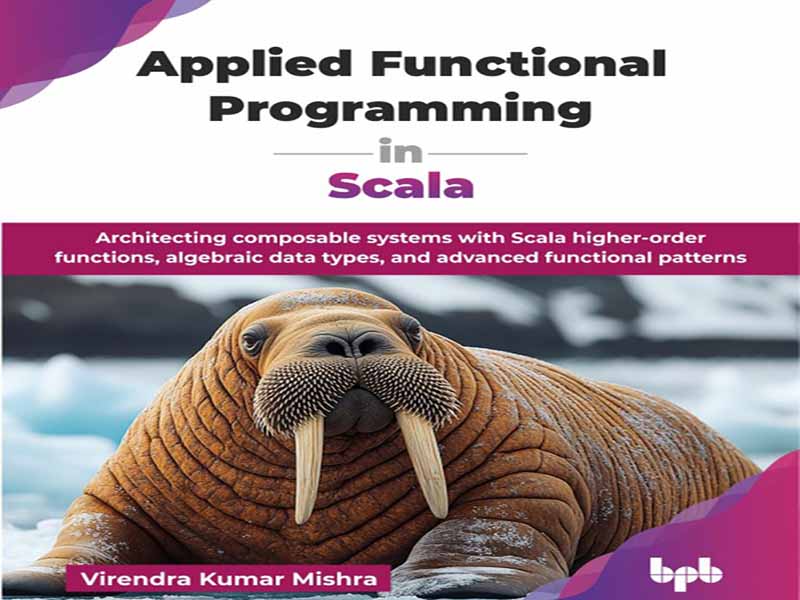- عنوان کتاب: Applied Functional Programming in Scala
- نویسنده: Virendra Kumar Mishra
- حوزه: برنامهنویسی Scala
- سال انتشار: 2025
- تعداد صفحه: 445
- زبان اصلی: انگلیسی
- نوع فایل: pdf
- حجم فایل: 4.68 مگابایت
برنامهنویسی تابعی به طور پیوسته از یک کنجکاوی نظری به یک الگوی عملی و قدرتمند برای ساخت سیستمهای نرمافزاری مدرن تکامل یافته است. با پیچیدگی روزافزون برنامهها و نیاز روزافزون به قابلیت اطمینان، همزمانی و قابلیت نگهداری، اصول اصلی برنامهنویسی تابعی، تغییرناپذیری، توابع خالص، قابلیت ترکیب و ایمنی نوع، بیش از هر زمان دیگری اهمیت یافتهاند. این کتاب سفری جامع از طریق اصول، الگوها و ابزارهایی است که توسعهدهندگان را قادر میسازد تا با استفاده از برنامهنویسی تابعی در اسکالا، برنامههای قوی و مقیاسپذیر بسازند. این کتاب با پایهگذاری مبانی نظری برنامهنویسی تابعی، معرفی مفاهیمی مانند توابع خالص، توابع مرتبه بالاتر و تغییرناپذیری آغاز میشود. این کتاب با کاوشی در نظریه دستهبندی، بر اساس این ایدهها بنا میشود و اهمیت آن را به عنوان ستون فقرات ریاضی برای انتزاعهای تابعی مانند مونادها، فانکتورها و فانکتورهای کاربردی نشان میدهد. سپس به توسعه عملی اسکالا میپردازیم و ویژگیهای زبان، کتابخانههای Cats و ZIO و کاربرد آنها در مدیریت عوارض جانبی را به روشی اصولی پوشش میدهیم. این فصلها خوانندگان را از طریق الگوهای تابعی پیشرفته، استفاده از اپتیک و پیادهسازی سیستمهای دنیای واقعی با استفاده از چارچوبهای وب مانند http4s، Tapir و ZIO HTTP هدایت میکنند. هر فصل بر اساس فصل قبلی بنا شده و در نهایت خواننده را در توسعه برنامههای کاربردی وب تابعی که قابل ترکیب، قابل آزمایش و مقیاسپذیر هستند، راهنمایی میکند. این کتاب برای توسعهدهندگانی طراحی شده است که میخواهند دانش خود را فراتر از تئوری ببرند و تکنیکهای برنامهنویسی تابعی را برای پرداختن به چالشهای نرمافزاری دنیای واقعی به کار گیرند. در نهایت، تئوری و عمل در یک مطالعه موردی جامع که تمام ابزارها و تکنیکهای قبلاً آموخته شده را ادغام میکند، همگرا میشوند. یک برنامه تجارت الکترونیک اسباببازی تابعی از ابتدا طراحی و پیادهسازی شده است و همه چیز را از ثبت نام کاربر و کاتالوگ محصول گرفته تا مدیریت سفارش، امنیت و تجزیه و تحلیل پوشش میدهد. نمودارهای معماری، الگوهای طراحی سرویس، طرحوارههای پایگاه داده و نقاط پایانی API، نمای کاملی از نحوه اعمال اصول برنامهنویسی تابعی در یک سیستم دنیای واقعی ارائه میدهند. فصل 1: مبانی برنامهنویسی تابعی – این فصل مبانی برنامهنویسی تابعی را که ریشه در حساب لامبدا دارد، معرفی میکند و آن را با پارادایمهای امری و شیءگرا مقایسه میکند. این فصل اصول اصلی مانند توابع خالص، تغییرناپذیری و ارزیابی کند را پوشش میدهد. با استفاده از اسکالا، ترکیب توابع، ماژولاریتی و مزایایی مانند قابلیت آزمایش، همزمانی و پیشبینیپذیری کد در برنامههای دنیای واقعی را برجسته میکند. فصل 2: پیادهسازی نظریه دستهبندی – این فصل نظریه دستهبندی را به عنوان پایه ریاضی برای ساختاردهی مفاهیم برنامهنویسی تابعی ارائه میدهد. این فصل دستهبندیها را به عنوان مجموعهای از اشیاء و مورفیسمها با ویژگیهایی مانند هویت و وابستگی توضیح میدهد. انتزاعات اصلی مانند نیمگروهها، مونوئیدها، فانکتورها، فانکتورهای کاربردی و مونادها، همراه با انواع عملی مانند خواننده، نویسنده و حالت، پوشش داده میشوند. این فصل همچنین اپتیک را برای دستکاری دقیق دادهها معرفی میکند و تئوری را به برنامهنویسی تابعی دنیای واقعی در اسکالا پیوند میدهد. فصل 3: مقدمهای بر اسکالا – این فصل اسکالا، یک زبان با نوع استاتیک در ماشین مجازی جاوا را معرفی میکند که برنامهنویسی شیءگرا و تابعی را با هم ترکیب میکند. این فصل ویژگیهای عملکردی اسکالا مانند توابع مرتبه بالاتر، عبارات لامبدا، کلوژرها، کاری کردن و کاربرد جزئی را پوشش میدهد. خوانندگان در مورد نصب اسکالا، راهاندازی محیط توسعه یکپارچه، تفاوتهای نسخه و مدیریت خطای عملکردی با Option، Try و either اطلاعات کسب میکنند. این فصل بر رفتار با توابع به عنوان شهروندان درجه یک و همسویی اسکالا با اصول برنامهنویسی تابعی تأکید دارد. فصل 4: درک Cats – این فصل به بررسی کتابخانه Cats، یک جعبه ابزار قدرتمند اسکالا که مبتنی بر نظریه دستهبندی برای پشتیبانی از برنامهنویسی تابعی است، میپردازد. این فصل کلاسهای نوع اصلی مانند functor، monad، applicative و traverse را برای کد ماژولار و قابل استفاده مجدد، همراه با انتزاعهای پیشرفته مانند contravariant و bifunctor معرفی میکند. این فصل semigroup، monoid، comonads و انواع داده مفید مانند Validated و Writer را پوشش میدهد و بر نقش Cats در ایجاد برنامههای کاربردی تابعی قابل ترکیب، ایمن از نوع و ایمن از اثر تأکید میکند. فصل 5: درک ZIO – این فصل کتابخانه ZIO را معرفی میکند، یک چارچوب کاملاً ایمن از نوع و کاربردی برای ساخت برنامههای کاربردی اسکالا همزمان، ناهمزمان و قابل آزمایش. این فصل نوع اصلی ZIO، نامهای مستعار اثر، جریان کنترل، مدیریت خطای ساختار یافته و منابع و همزمانی با fibers و STM را توضیح میدهد. ویژگیهایی مانند ZLayer برای تزریق وابستگی و zio.test برای آزمایش مؤثر برجسته شدهاند که قدرت ZIO را در ایجاد برنامههای مقیاسپذیر، ماژولار و قابل نگهداری نشان میدهد. فصل 6: پیادهسازی اثرات به روش خالص – این فصل تفاوت بین اثرات و عوارض جانبی را روشن میکند و چالشهایی را که عوارض جانبی برای خلوص عملکردی ایجاد میکنند، برجسته میکند. این فصل استراتژیها را بررسی میکند…
Functional programming has steadily evolved from a theoretical curiosity into a practical and powerful paradigm for building modern software systems. With the growing complexity of applications and the increasing need for reliability, concurrency, and maintainability, the core tenets of functional programming, immutability, pure functions, composability, and type-safety have become more relevant than ever. This book is a comprehensive journey through the principles, patterns, and tools that empower developers to build robust and scalable applications using functional programming in Scala. The book begins by laying the theoretical foundations of functional programming, introducing concepts like pure functions, higher order functions, and immutability. It builds on these ideas with an exploration of category theory, showcasing its importance as a mathematical backbone for functional abstractions such as monads, functors, and applicative functors. We then transition into hands-on Scala development, covering the language’s features, Cats and ZIO libraries, and their use in managing side effects in a principled way. The chapters lead readers through advanced functional patterns, the use of optics, and the implementation of realworld systems using web frameworks such as http4s, Tapir, and ZIO HTTP. Each chapter builds on the previous one, ultimately guiding the reader in developing functional web applications that are composable, testable, and scalable. This book is designed for developers who want to take their knowledge beyond theory and apply functional programming techniques to address real-world software challenges. Ultimately, theory and practice converge in a comprehensive case study that integrates all previously learned tools and techniques. A functional toy e-commerce application is designed and implemented from scratch, covering everything from user registration and product catalog to order management, security, and analytics. Architectural diagrams, service design patterns, database schemas, and API endpoints offer a complete view of how functional programming principles are applied to a realworld system. Chapter 1: Fundamentals of Functional Programming – This chapter introduces the fundamentals of functional programming, rooted in lambda calculus, and contrasts it with imperative and object-oriented paradigms. It covers core principles like pure functions, immutability, and lazy evaluation. Using Scala, it highlights function composition, modularity, and benefits like testability, concurrency, and code predictability in real-world applications. Chapter 2: Implementation of Category Theory – This chapter presents category theory as the mathematical foundation for structuring functional programming concepts. It explains categories as collections of objects and morphisms with properties like identity and associativity. Core abstractions such as semigroups, monoids, functors, applicative functors, and monads are covered, along with practical types like reader, writer, and state. The chapter also introduces optics for precise data manipulation, linking theory to real-world functional programming in Scala. Chapter 3: Introduction to Scala – This chapter introduces Scala, a statically-typed language on the Java Virtual Machine that blends object-oriented and functional programming. It covers Scala’s functional features such as higher order functions, lambda expressions, closures, currying, and partial application. Readers learn about Scala installation, integrated development environment setup, version differences, and functional error handling with Option, Try, and Either. The chapter emphasizes treating functions as first-class citizens and Scala’s alignment with functional programming principles. Chapter 4: Understanding Cats – This chapter explores the Cats library, a powerful Scala toolkit grounded in category theory to support functional programming. It introduces core type classes like functor, monad, applicative, and traverse for modular, reusable code, along with advanced abstractions like contravariant and bifunctor. It covers semigroup, monoid, comonads, and useful data types like Validated and Writer, emphasizing Cats role in creating composable, type-safe, and effect-safe functional applications. Chapter 5: Understanding ZIO – This chapter introduces ZIO library, a type-safe, purely functional framework for building concurrent, asynchronous, and testable Scala applications. It explains ZIO’s core type, effect aliases, control flow, structured error and resource management, and concurrency with fibers and STM. Features like ZLayer for dependency injection and zio.test for effectful testing are highlighted, showcasing ZIO’s power in creating scalable, modular, and maintainable applications. Chapter 6: Effects Implementation in Pure Way – This chapter clarifies the difference between effects and side effects, highlighting the challenges side effects pose to functional purity. It explores strategies for managing them using pure functions, immutability, and abstractions like monads. Libraries like Cats Effect and ZIO offer tools for safe, type-safe I/O and exception handling. Practical examples demonstrate building scalable, maintainable applications by isolating side effects through functional design principles. Chapter 7: Functional Pattern Implementation – This chapter covers functional design patterns for building composable, scalable, and effect-safe Scala applications. It introduces domain-specific languages using ADTs and improves them with tagless final encoding for better modularity. It explores free monads and functors to separate computation from execution, and explains ZIO layer for dependency injection, highlighting modularity, testability, and resource safety in functional architectures. Chapter 8: Functional Tools – This chapter introduces essential Scala functional tools for building robust, typesafe, and composable applications. It covers Monocle for immutable data manipulation, Monix for reactive programming, Caliban for type-safe GraphQL, Circe for JSON handling, and ZIO scheduling for concurrency. Additionally, it presents PureConfig for configuration, FS2 for streaming, and Cats collections and retry for functional data structures and retry policies, enabling practical, real-world functional solutions. Chapter 9: Web Implementation in Functional Way – This chapter covers building web applications with functional programming principles like immutability, pure functions, and composability. It highlights functional programming benefits in web development such as easier state management, concurrency, and testability. Key Scala libraries including http4s, Tapir, ZIO HTTP, and sttp are introduced. A to-do app example demonstrates functional HTTP routing and response handling, setting the stage for subsequent functional database integration. Chapter 10: DB Implementation in Functional Way – This chapter covers functional database operations in Scala, emphasizing immutability, pure functions, and side-effect control using monads like IO. It compares four Scala libraries: Slick (type-safe, composable queries), Quill (compile-time query generation), doobie (pure functional raw SQL with Cats Effect), and Skunk (PostgreSQL-focused, highly type-safe). Practical examples include a to-do app with Skunk and guidance on choosing the right library for functional DB access. Chapter 11: Functional Streams for Scala – This chapter explores functional streams in Scala, highlighting their lazy, composable, and resource-efficient handling of large or infinite data sequences. It covers transformations like map, filter, and reduce while maintaining immutability and sideeffect isolation. The chapter introduces FS2 and ZIO streams libraries, comparing their features, concurrency support, and use cases such as real-time analytics and reactive applications, guiding developers to build scalable, efficient data pipelines. Chapter 12: Case Study on Functional Toy Ecommerce Site – This chapter presents a case study on building a toy e-commerce site using functional programming principles and tools. It covers user management, product catalog, cart, checkout, order processing, payments, inventory, reviews, analytics, customer support, and security within a layered architecture. Using Scala, Skunk, and React, the design emphasizes modular, composable services with type-safety, immutability, and effectful computations, illustrating the practical and scalable development of functional applications.
این کتاب را میتوانید از لینک زیر بصورت رایگان دانلود کنید:
Download: Applied Functional Programming in Scala



































نظرات کاربران